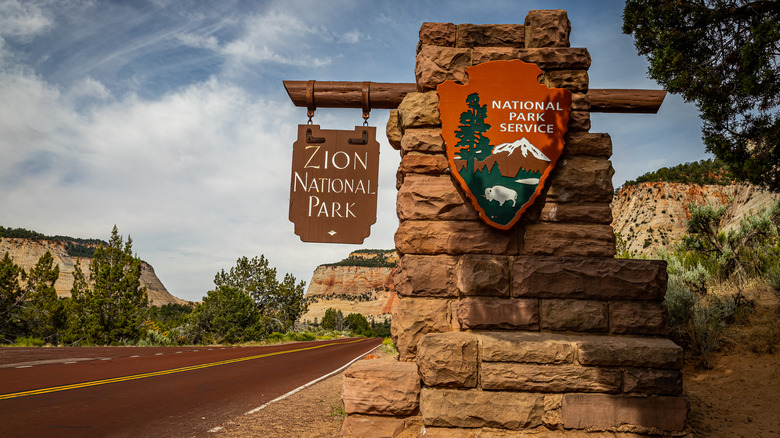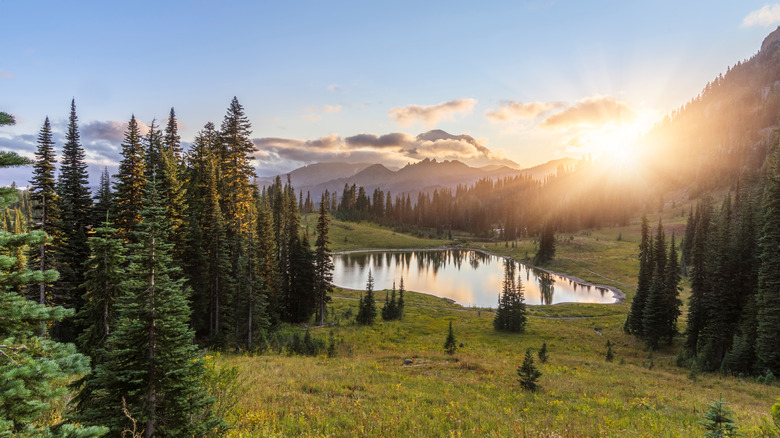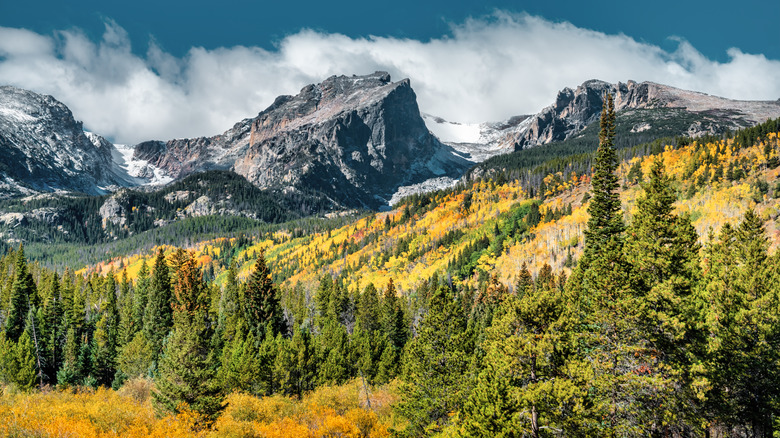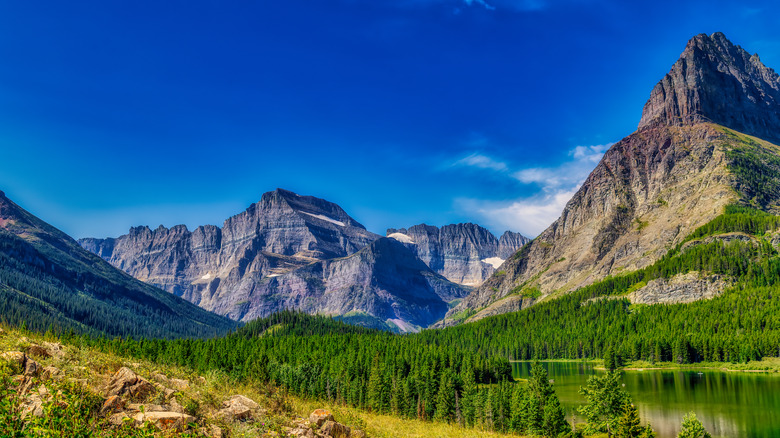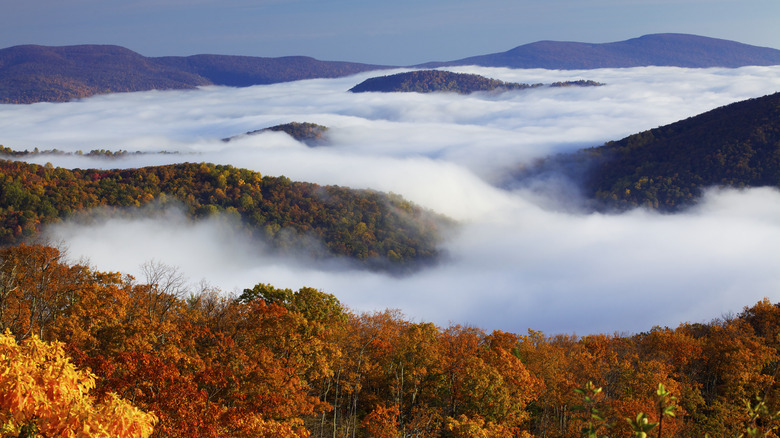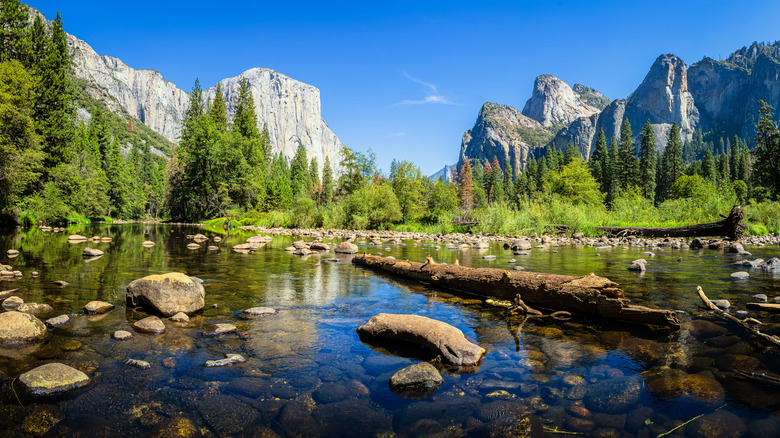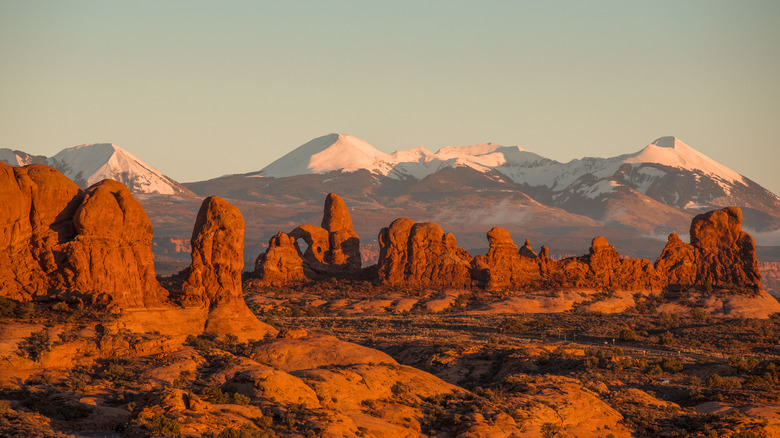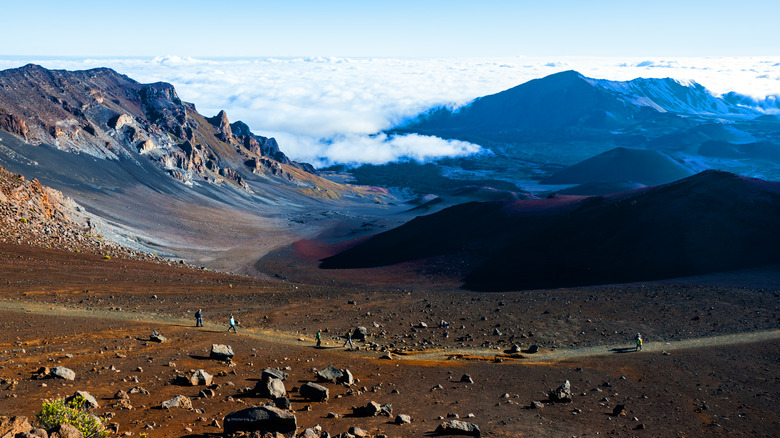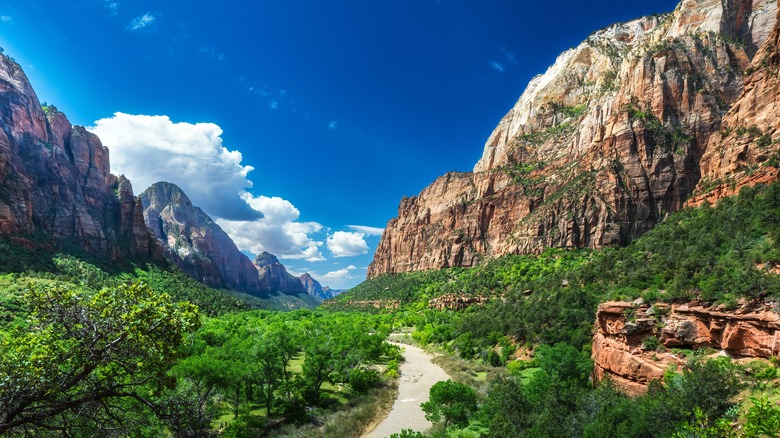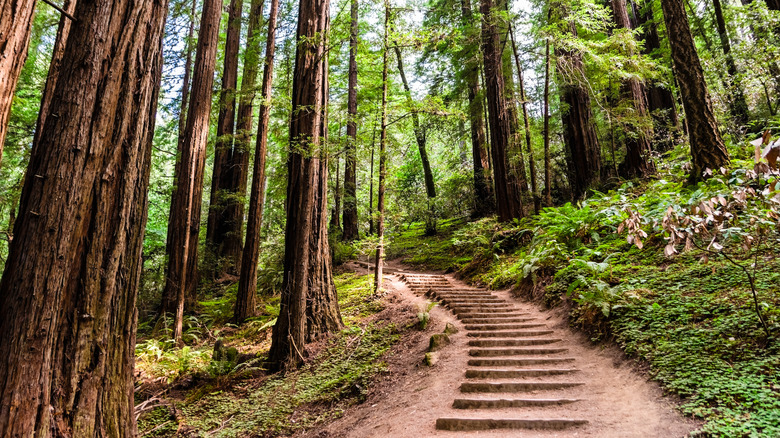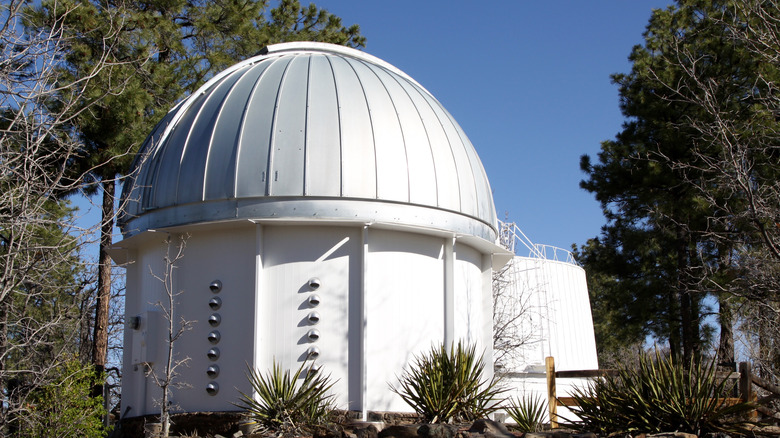National Parks You May Not Know Require Reservations
"National parks are the best idea we ever had ... they reflect us at our best rather than our worst," wrote Wallace Stegner in 1983 (via the National Park Service). Indeed, the 63 national parks and 425 total national park sites (National Recreation Areas, National Monuments, etc.) represent some of America's most spectacular landscapes and spaces of historical significance. From the Edmund Pettis Bridge in Selma, Alabama, to Alaska's Kiska Island, home to a brief Japanese occupation during World War II, National Historical Landmarks and Parks document some of the most transcendent points of growth (or trauma) in the American experience.
Many national parks, monuments, and historical sites are free to enter and can be accessed without many restrictions. They are part of the American tapestry and are therefore maintained in such a way that freely allows visitors to explore these protected areas. However, you might be surprised to learn that several parks and other sites require tickets and reservations to access some or all of their bountiful offerings.
The National Park Service (NPS) is the administrative arm of the federal government that cares for the nation's most valuable treasures. To ensure responsible stewardship, the NPS requires reservations as a means to preserve the integrity of the land — as a high volume of explorers can negatively impact the area. However, reservations aren't usually too hard to come by (since competitive pricing isn't the goal), but you'll still want to plan ahead and book early to avoid disappointment or imposed schedule changes at these national park sites.
Mount Rainier National Park, Washington
Mount Rainier National Park is one of the United States' most visited national park sites. According to NPS, 1.6 million people visited the park in 2022, spiking visitation substantially over the routine levels seen in the previous decade. With such a dramatic surge in interest, the park has naturally experienced larger crowds and elongated wait times for entry and more. To resolve this continuing issue, the park has instituted a reservation system to create timed entry slots for the first time.
This approach is set to be tested in 2024 to alleviate stress on the park and its natural habitat, but also to provide traffic relief for local residents who have found their driveways and access roads blocked for hours at a time. Timed entries will spread visitor arrival times out across the day to create a more even distribution, and it will affect two areas of the park: Paradise Corridor (coming from the southwest from May 24 to September 2) and Sunrise Corridor (arriving from the northeast and in effect between July 3 and September 2).
Entry is good for a single day, and time slots can be reserved between 7 a.m. and 3 p.m. for either entrance. The park is open at all times, and visitors arriving outside of this window are free to pass into the park without a reservation. If you're staying at a hotel or campground within the park, you'll need to arrive after 1 p.m. on the first day of your stay, however. These kinds of accommodations stand in for a timed entry reservation.
Rocky Mountain National Park, Colorado
Colorado's Rocky Mountain National Park will bring back a similar reservation program to the pilot from 2023. The park will be split into two permitted sections. Visitors can secure a timed entry permit for the Bear Lake Road Corridor and the rest of the park, or a "rest of the park" permit that does not include access to the Bear Lake Road Corridor. For the first permit type, visitors will need a reservation to enter between 5 a.m. and 6 p.m. between May 24 and October 20, while the "rest of the park" permit will cover entry times between 9 a.m. and 2 p.m. from May 24 to October 15. All permits offer a two-hour window for timed entry and don't stipulate a duration limit or mandated departure time. The reservations themselves are free, but to book a time slot, you'll have to pay a $2 processing fee.
Reservations will become available on the first of each month for the following month, so August's timed entry slots will be open to reserve on July 1. Also, around 40% of all entry times will be held back for next-day reservations. This means that visitors who aren't able to snag their preferred entry can look online the day before they want to hike or explore the national park for a second chance at booking a preferred entry time.
Glacier National Park, Montana
Glacier National Park — the "Crown of the Continent" — is complete with 700 miles of hiking trails and far fewer visitors annually than its close neighbor, Yellowstone National Park. It's one of the most spectacular natural vistas you'll see in the United States, but to explore Glacier National Park during peak season, you'll need to secure a vehicle reservation. Like others, the reservation's cost comes in the form of a $2 processing fee on recreation.gov. (To note, this is the only place you can book a reservation: So don't get duped by imposters).
Reservations can be made 120 days in advance of the entry date you're hoping to secure, starting on January 25 and continuing on a rolling basis from then on. Next-day reservations are also available and are released at 7 p.m. MDT for the next day (starting on May 23). For entry between 6 a.m. and 3 p.m., a reservation is required, regardless of where you're planning to visit in the park. Entry outside of these times can be achieved without a vehicle reservation, but you'll still need to pay entry fees or organize your park pass to get in.
Between May 24 and September 8, vehicle reservations are required for the North Fork and the western portion of Going-to-the-Sun Road, and the Many Glacier area requires a reservation between July 1 and September 8. Unlike previous reservations, in 2024, your timed entry slot is only good for the day you select, rather than the three-day window that visitors could previously utilize.
Shenandoah National Park, Virginia
Shenandoah National Park lends a 101-mile stretch of its vast landscape to the Appalachian Trail, and since it's centrally located on the East Coast, it's a highly visited landscape. Due to its popularity, Shenandoah National Park has a now-permanent ticketing system. The Old Rag Mountain is a great site for hiking and camping, but to access the mountain's base, trail, and summit, you'll need to get on the day-ticket list — in addition to paying the park entrance fee.
The park offers 800 day-use tickets for each day, starting on March 1 and running through November 30. Fortunately, anyone hoping to hike the Old Rag Mountain will have two separate opportunity windows to snag an entry ticket on their chosen day. Half of each day's tickets will be released 30 days before the date in question, and the other 400 tickets will become available five days before the ticket date.
This ticketing process begins at 10 a.m. on February 17, and reservations will cost the standard $2 processing fee. The aim of the ticketing process is to improve the experience for every hiker who braves the mountain. Limiting entry to just 800 people per day will also help preserve the natural habitat while giving everyone on the mountain an unforgettable hike.
Yosemite National Park, California
Yosemite welcomes over 3.5 million people every year and is a surprisingly hiker-friendly destination for beginners. But in 2024, visitors will have to make entry reservations ahead of their trip into the park. In fact, the reservation calendar is somewhat hectic because multiple time periods experience massive crowds at Yosemite National Park. For instance, crowds gather at the park's Horsetail Fall to see the glorious orange flare at sunset throughout February. Between February 10 and 25, visitors arriving on Saturdays, Sundays, Mondays, and February 19 (Presidents' Day or Washington's Birthday) will need a reservation, regardless of the time. Reservations are designed to help alleviate stress on the park's infrastructure and habitat during one of its busy periods.
Later in the spring and summer, visitors will again need a reservation. From April 13 to June 30, weekends and holidays — Memorial Day and Juneteenth (occurring on May 27 and June 19, respectively) — require a timed entry slot between 5 a.m. and 4 p.m. Then, through July 1 and August 16, visitors will need to successfully reserve an entry slot for every day of the week. Finally, from August 17 to October 27, reservations return to weekends and holidays only (Labor Day on September 2, and Columbus Day/Indigenous People's Day, which is observed in California, on October 14). Reservations are $2, and the timed entry window is from 5 a.m. to 4 p.m.
Arches National Park, Utah
Utah's Arches National Park is another scenic destination that requires visitors to make reservations in advance for most entries throughout the spring, summer, and fall. Between April 1 and October 31, visitors entering between 7 a.m. and 4 p.m. will need to make a reservation. Entry time slots are designed to keep the park accessible and well-maintained as interest in America's natural treasures continues to increase. Reservations open up for booking three months in advance and open as monthly blocks. April reservations become available on January 2, and reservations for June open at 8 a.m. MST on March 1, for example.
Visitors who missed out on their preferred time slot will be able to vie for next-day reservations, as well. These open at 7 p.m. the night before. As with other national parks, the reservation will cost $2 and should be purchased through recreation.gov. Unlike others, the reservation system covers the entire park, so visitors can explore the 2,000-plus arches found within this segment of the Utah desert. However, entry before or after the slotted time window is also allowed, so getting up bright and early to explore Arches National Park is an option.
Haleakalā National Park, Maui Island, Hawaii
Haleakalā National Park is one of America's most far-flung treasures. Located on Maui Island, it encompasses more than 75% of the island's total landmass. The volcanic fields are home to endangered and highly localized species of Hawaiian animals, and the park aims to preserve sacred Hawaiian heritage and culture, as well. Exploring Haleakalā National Park won't require a special permit or reservation unless you want to partake in the park's most revered tradition. Arriving at the summit before the Sun comes up offers an experience unlike any other, but to take in this breathtaking scene, you'll need to nab an entry time slot. If you don't have a reservation, you won't be able to enter the park until after 7 a.m., too late to experience the sunrise.
Making a reservation for sunrise is required year-round, and allows you to take up a spot on the summit anytime between 3 a.m. and 7 a.m. Bookings can be made up to 60 days before the day you wish to watch the sunrise, and they are released at 7 a.m. HST. Tickets often sell out within about 15 minutes, so planning ahead is a must. However, there are a select number of tickets held in reserve and released two days before each entry date. The cost for these entry reservations is $1.
Acadia National Park, Maine
Maine's beautiful seascape park offers a one-of-a-kind adventure. The national park covers a sprawling landscape of almost 50,000 acres throughout Mount Desert Island (as well as a few other islands) and the Schoodic Peninsula off Maine's Atlantic coast. The park sweeps through a variety of residential areas that are home to a select group of truly blessed Maine residents, however. Acadia National Park is the fifth-most visited park in the National Park Service's network, and according to NPS, welcomes around 4 million visitors annually. All that traffic wreaks havoc on the small community's peace and quiet, as well as its infrastructure. As a result, the Cadillac Summit Road requires an advanced reservation between May 22 and October 27 to keep traffic spread out and the environmental impact of millions of visitors to a minimum.
Thirty percent of reservations dedicated to sunrise and daytime time slots can be purchased 90 days ahead of the target date, while 70% of reservations become available at 10 a.m. EST two days before the requested date. This reservation system is a result of five years of planning to identify options for maintaining the park while optimizing public access. The Cadillac Summit drive is the only portion of Acadia affected by this reservation requirement, and only visitors traversing the area by car must make a reservation. Visitors on foot or bike won't need one. Reservations cost $6 and can be made at recreation.gov.
Zion National Park, Utah
Zion National Park is Utah's first, and it's home to an abundance of plant and animal life, as well as stunning scenery. Hikers flock to Zion National Park to explore its nooks and crannies, but hiking Angels Landing will require you to procure a permit before setting off. This is one of Zion's most dangerous hiking trails, and traffic on the route has become unsustainable in recent years. To combat overcrowding, the National Park Service began a pilot program in 2019 to offer permits to spread out the traffic for a safer hiking trail.
All passes are awarded via a lottery system. It costs $6 to enter your name (including up to six total people in your group) into the lottery, and if you are chosen, you'll be charged $3 per person for the permit. Lotteries are conducted for three-month blocks, with the window opening two months before the first hike date for 20 days. For instance, the lottery window for dates between June 1 and August 31 opens on April 1 and closes on April 20. Winners will be notified on April 25. In 2024, the trail will be closed between April 1 and 4 for maintenance.
In addition, hikers with their eyes set on a certain date can apply for the next-day lottery. If you want to hike on April 16, for instance, you'll need to enter on April 15 between 12:01 a.m. and 3 p.m. If you're successful, you'll be issued your permit at 4 p.m. ahead of your hike the next day.
Muir Woods National Monument, California
Muir Woods National Monument is a protected old-growth redwood forest near San Francisco. The forest is part of the Golden Gate National Recreation Area and makes for a fabulous day out if you're visiting the Bay Area. But to visit the forest, you'll need to make a vehicle parking or shuttle reservation before setting off for the day.
For a typical car, drivers will need to purchase a $9.50 parking reservation, as well as the $15 entrance fee for each adult (16 and over). Entry is free for children under 16. Shuttle reservations are free for children and cost $3.75 per adult rider (for a round-trip ticket). "Medium" and "large" vehicle reservations must be made for any vehicle over 17 feet or 22 feet, respectively. Any vehicle larger than 35 feet cannot be parked at Muir Woods. Medium vehicles cost $30 and large vehicles cost $45.
Reservations are required throughout the year and offer a 30-minute window for arrival. They can be made up to three months in advance and have been known to sell out, especially during busy holiday times and on weekends.
Lowell Observatory National Historical Landmark, Arizona
The National Historical Landmark that is Arizona's Lowell Observatory is a special site indeed. This is the facility where Clyde Tombaugh discovered Pluto in 1930, perhaps surprisingly, nearly 40 years after the observatory was established (in 1894)! Only about 70,000 people explore this fascinating site every year, and they are truly among the lucky explorers. General admission is $29 for adults, $19 for college students, and $17 for children between 5 and 17. However, a routine tour of the facility and its telescopes, history, and grounds isn't the only draw.
The Lowell National Historical Park hosts a full schedule of events and activities throughout the year. These events require special use permits that are issued by the National Park Service. Some upcoming events in 2024 include the I Heart Pluto Festival on February 18, as well as numerous "meet an astrophysicist" evenings throughout the year and a virtual eclipse viewing event for the April 8 solar eclipse. Anyone planning their own event may be able to host it at the Lowell Observatory, too, granted it doesn't "impair park values and resources," per the National Park Service.
